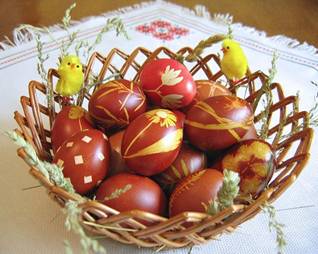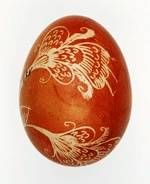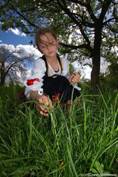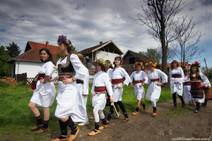In most Slavic languages, the name for Easter either means "Great Day" or "Great Night". For example, Wielkanoc, Veľká noc and Velikonoce mean "Great Night" or "Great Nights" in Polish, Slovak and Czech, respectively. Велигден (Veligden), Великдень (Velykden), Великден (Velikden), and Вялікдзень (Vyalikdzyen') mean "The Great Day" in Macedonian, Ukrainian, Bulgarian, and Belarusian, respectively.
In Serbian, however, the day's name reflects a particular theological connection: it is called Uskrs, meaning "Resurrection". It also explains the fact that in Serbian Easter is sometimes also called Vaskrs, a liturgical form inherited from the Serbian recension of Church Slavonic.
Easter church services are followed by families having their baskets of colored eggs blessed by the parish priest. Usually the eggs are red symbolizing happiness, joy, rebirth and the blood of Christ. Families exchange eggs and say, Hristos Voskrese (Christ is risen). The response is Voistinu Voskrese (Indeed He is risen).
Central to the Serbian celebration of Easter is the egg, the seasonal symbol of new life. Easter eggs in Western Europe can be made of chocolate and sold in supermarkets. However, Serbs use ordinary chicken eggs at Easter, boiling scores of them at home on Good Friday.
While the Easter weekend is the climax of the celebration, for many Serbs the festivities start in earnest on Lazar’s Saturday, April 16th. On that day, church floors are covered for the afternoon mass with the flower known as vrbica, or in English, purple loosestrife.
During the ceremony, the priest blesses the flowers and shares them with believers.
This day marks Jesus’ entry into Jerusalem. Vrbica is a Serbian version of the palm fronds that children laid down on Jesus’ path. Believers also make wreaths out of vrbica flowers and place them on their front doors, while children wear little bells around their necks as a symbol of Jesus’ coming.
 The tradition is dyeing the first set of eggs in red and setting one of them aside until next Easter. That egg is called the housekeeper, referring to the belief that the egg will help protect the home.
The tradition is dyeing the first set of eggs in red and setting one of them aside until next Easter. That egg is called the housekeeper, referring to the belief that the egg will help protect the home.
Although coloured dyes for the eggs can be bought in the market, most people still dye at least 10 eggs by boiling them with an onion.
The onion gives the eggs a nice caramel colour. And if you want to create a pattern on the egg, just draw on it with wax before boiling.
Although Easter bunnies are becoming more popular, the animal that truly symbolises Easter for Serbs is the baby chick – the natural product of the egg. Young children often play with stuffed toys of chicks.
After colouring Easter eggs, families traditionally spend the afternoon at mass. The Good Friday Mass is performed in front of a replica of Jesus’ shroud, symbolising the removal the body from the cross. In some churches, believers pass under the shroud after the ceremony and make a wish.
Saturday is reserved for decorating homes. Easter Sunday starts with bells ringing in churches throughout the country.
In the Orthodox tradition, believers give up certain foods during the 40 days up to the Easter, making Easter Sunday a much-awaited feast.
After morning mass, families have breakfast together and play the game of ‘tucanje’, which involves cracking eggs against each other to see which one breaks first.
Most Serbs spend Easter visiting friends and family. The phrase exchanged most commonly in greeting is “Hristos Vaskrse”, meaning, “Christ is Risen”. The response is Voistinu Voskrese (Indeed He is risen).
It is standard practice to exchange coloured eggs between hosts and guests.
 Easter eggs are special eggs that are often given to celebrate Easter. The egg is seen as a symbol of resurrection: while being dormant it contains a new life sealed within it.
Easter eggs are special eggs that are often given to celebrate Easter. The egg is seen as a symbol of resurrection: while being dormant it contains a new life sealed within it.
Easter eggs are dyed red to represent the blood of Christ, shed on the Cross, and the hard shell of the egg symbolized the sealed Tomb of Christ — the cracking of which symbolized His resurrection from the dead. Easter eggs are blessed by the priest at the end of the Paschal Vigil (which is equivalent to Holy Saturday), and distributed to the faithful. Each household also brings an Easter basket to church, filled not only with Easter eggs but also with other Paschal foods such as paskha, kulich or Easter breads, and these are blessed by the priest as well.
While the origin of easter eggs can be explained in the symbolic terms described above, a sacred tradition among followers of Eastern Christianity says that Mary Magdalene was bringing cooked eggs to share with the other women at the tomb of Jesus, and the eggs in her basket miraculously turned brilliant red when she saw the risen Christ.The egg represents the boulder of the tomb of Jesus.[3]
A different, but not necessarily conflicting legend concerns Mary Magdalene's efforts to spread the Gospel. According to this tradition, after the Ascension of Jesus, Mary went to the Emperor of Rome and greeted him with "Christ has risen," whereupon he pointed to an egg on his table and stated, "Christ has no more risen than that egg is red." After making this statement it is said the egg immediately turned blood red.
Vrbica (Врбица) or Lazareva Subota (Serbian: Лазарева субота, Lazarus Saturday) is a Serbian Orthodox tradition that has origins in the Eastern Christian feast of Lazarus Saturday, however the feast has its own features. The feast celebrates the resurrection of Lazarus of Bethany, the narrative of which is found in the New Testament Gospel of John (John 11:1-45).
The feast is also to commemorate Tsar Lazar, a national symbol and the King of Serbia who fought and died at the historical Battle of Kosovo in 1389 against the invading Ottoman Turkey. It is believed that Lazar led the procession and since the ritual (Lazarice) is held every year at his name day.
 Features
Features

Lazarice is a Serbian tradition of procession during the Serbian Orthodox feast of Lazareva Subota (Lazarus Saturday, the Serbian Orthodox feast is different from other churches) the parade consists of six (or more) maids.
The Forty Days of Great Lent commemorates Israel's forty years of wandering in the Wilderness the forty years of painful struggle as Israel longed for and then received entrance into the Promised Land (Ex. 16:35) Moses remained fasting on Mt. Sinai for forty days (Ex. 34:28) and the Prophet Elijah fasted for forty days as he journeyed to Mt. Horeb (1 Kings 19:8). Great Lent also recalls the forty days the Lord spent in the Wilderness after His Baptism, when He contended with Satan, the Temptor.
The time of Great Lent encompasses forty days, to which must be added Lazarus Saturday, Palm Sunday and Passion Week. In addition, the Holy Church prescribed three weeks of preparation for the Great Lent itself the Sundays of the Publican and the Pharisee, Prodigal Son, Meatfare and Cheesefare. In all, the Orthodox Church prescribes ten weeks of spiritual and bodily preparation for the joyous Pascha of the Lord.
The Date of Pascha.
The time of the Great Lent is dependent on the date of Pascha, which varies from year to year. According to a Canon of the First Ecumenical Council (Nicea 325), Holy Pascha is the first Sunday after the first Full Moon which falls upon or immediately after the Spring Equinox (according to ancient reckoning March 21). In addition, this Council decreed that Pascha cannot precede or fall on the Jewish Passover (14th day of the Month Nissan). The Full Moon used for the purposes of calculating the date of Pascha is the fourteenth day of a Lunar Month reckoned according to an ancient ecclesiastical computation and is not the actual astronomical Full Moon.
The number of days between each Full Moon (the Lunar Month) is not exact according to the Solar Calendar (usually about 29V& days) and ancient calendars added or subtracted a period called an epact to harmonize the Lunar and Solar Calendars. These epacts as calculated by the Orthodox Church, vary from those calculated by the Western Churches. In addition, the Western Churches do not follow the Nicean Council's decree that Pascha must not precede or fall on the Jewish Passover, and it is for these reasons that there is often a great variance from one year to the next between the Orthodox Church and the Western Churches concerning the date of Holy Pascha.
Sundays of Preparation
Sunday of the Publican and the Pharisee
The first Sunday of Preparation (three weeks before the start of Great Lent) is the Sunday of the Publican and the Pharisee, in which we are exhorted to true repentance and encouraged to follow the self-abasement of the Publican rather than the spiritual pride of the Pharisee. At the Matins Service we sing for the first time the beautiful Lenten hymn, Open to me the gates of repentance.../'reminding us of the open gateway through which all must enter on the way to Pascha. We also note that this week is fast-free.
Sunday of the Prodigal Son
The next Sunday of Preparation (two weeks before Great Lent) is the Sunday of the Prodigal Son, which reminds us that not only must we repent and undergo a change of heart, but that we must also exercise an act of will, in that we must get up and actually set off on our journey. In our own lives we can see a parallel; for how often do we repeat the cycle of the Prodigal son willful departure from God's house, a life of wantonness, misery at our fallen state, repentance, return to god the Father and divine forgiveness? On this Sunday, at the Matins Service we also sing the beautiful hymn of remembrance, By the waters of Babylon... (also sung the next two Sundays), reminding us of the heavenly Zion from which we have been exiled.
Sunday of Meatfare Sunday of the Last Judgment.
The next Sunday of Preparation, Meatfare Sunday, is the last day on which meat is permitted to be consumed until Holy Pascha. Otherwise, during the course of this week, on each day, all other animal products (including milk, cheese, eggs, butter, as well as fish) may be consumed. This is to remind us of the upcoming rigors of the Great Fast. The theme of this Sunday is the Last Judgment and the lot of those who turn from God, and those who return to Him.
Sunday of Cheesefare Forgiveness, Sunday of the Expulsion of Adam from Paradise
The last Sunday before the Great Lent, Cheesefare Sunday, is also the last day of preparation. It is called Cheesefare because on the next day we begin a total fast from all animal products, as well as from fish, wine and oil (fish, wine and oil will be allowed only on the Feasts of the Annunciation and Palm Sunday), continuing until Holy Pascha. An important theme of this day is the Expulsion of Adam from Paradise, which reminds us of that from which we have fallen. Another theme is forgiveness, since we cannot even begin our spiritual journey without granting forgiveness to those who have offended us and asking forgiveness of those whom we have offended. A special feature of this day is the very moving Forgiveness Vespers, at which we all ask and grant mutual forgiveness. At this Service, after the singing of the Great Prokeimenon, the liturgical vestments and furnishings are changed to dark colors, and the special Lenten melodies used.
Great Lent.
On the Monday following the Sunday of Cheesefare, we formally begin the 40-day Great Lent and, of course, one of its features is its rigorous fasting (cf. the section entitled Fasting in this chapter). In addition, there are some special features of the liturgical Services. The usual Liturgy of St. John Chrysostom is not served on the weekdays of Great Lent (with the exception of the Feast of the Annunciation), but is replaced by the special Liturgy of the Presanctified Gifts, at which the faithful commune of the Holy Gifts which were presanctified at the previous Sunday's Liturgy. In addition, the penitential Service of Great Compline is sung, at which, on the first four days of this first week (as well as on Thursday of the Fifth Week) the Great Canon of St. Andrew of Crete is read. This Canon is a long penitential composition of 250 verses expressing the longings of a guilty and penitent soul.
This week we are also introduced to the moving Lenten prayer of St. Ephraim the Syrian, setting forth the essence of spiritual life. This prayer is said at each of the liturgical Services throughout the weekdays of Great Lent and the first half of Passion Week.
The Lenten Prayer of St. Ephrem the Syrian
O Lord and Master of my life! Take from me the spirit of sloth, despair, lust of power and idle talk.
But give rather the spirit of chastity, humility, patience and love to Thy servant.
Yea, O Lord and King! Grant me to see my own transgressions and not to judge my Brother; for Blessed art Thou, unto ages of ages. Amen.
All of the Sundays of Great Lent (with the exception of Palm Sunday) the usual Liturgy of St. John Chrysostom is replaced by the longer Liturgy of St. Basil the Great. This Liturgy is especially characterized by its longer and very moving prayers.
First Sunday of Great Lent Sunday of Orthodoxy
The First Sunday of Great Lent is dedicated to the final triumph of the Church over the iconoclasts and the restoration of the Holy Icons to the churches, which took place on the First Sunday of Lent, March 11, 843. Thus it is called the Sunday of Orthodoxy. As the Orthodox triumphed during the iconoclastic controversy because of the dedication of the Martyrs and Confessors who suffered for the Faith, so too, we strive to imitate these Martyrs by our own ascetical self-denial. A special feature of this day is the Office of Orthodoxy, at which a procession with the Holy Icons is made, and sixty anathemas pronounced against various heretics and heresies of the 4th-14th Centuries.
Second Sunday of Great Lent St. Gregory Palamas
The Second Sunday of Great Lent is dedicated to St. Gregory Palamas, Archbishop of Thessalonica. St. Gregory's triumph over the heretics of his time is seen as a renewal of the Triumph of Orthodoxy of the previous Sunday. Another theme of this Sunday is that of the Prodigal Son as a model of repentance, for which a special Canon is devoted at this Sunday's Matins.
Third Sunday of Great Lent Veneration of the Cross
The Third Sunday of Great Lent is dedicated to the Cross and the bringing-out of the Precious Cross, which closely parallels the ceremonies of the Feast of the Exaltation of the Cross on Sept. 14. At this time we are reminded of the upcoming crucifixion of the Lord and strengthened to persevere in our Lenten struggles.
The Fourth Sunday of Great Lent St. John Climacus
The Fourth Sunday is dedicated to St. John Climacus (of The Ladder), Abbot of Sinai, who, because of his ascetical writing (The Ladder) serves as a model of a true Christian ascetic. The Ladder is appointed by the Church to be read during Great Lent. In the course of this week (the Fifth Week of Great Lent) the Great Canon of St. Andrew of Crete is read on Thursday in its entirety, as well as a Canon to St. Mary of Egypt. In addition, St. Mary's Life is read. On Saturday of this week the Akathist Hymn to the Most-Holy Theotokos is sung with everyone standing (Akathistos means not sitting). It reminds us that we are dependent on the protecting intercession of the Holy Theotokos at all moments of crisis and danger.
The Fifth Sunday of Great Lent St. Mary of Egypt
The Fifth Sunday of Great Lent is dedicated to St. Mary of Egypt. St. Mary was a harlot living in the Egyptian city of Alexandria who later repented and lived the rest of her life in solitude in the Egyptian desert, serving as a model of repentance to all Christians. The end of this week the Sixth marks the end of Great Lent and the beginning of Passion Week.
Passion (Holy) Week
Lazarus Saturday and Palm Sunday
Immediately after the end of the forty days of penitence and before the days of darkness and mourning of Passion Week, the Holy Church celebrates the bright festivals of Lazarus Saturday and Palm Sunday. Lazarus Saturday commemorates the raising of Lazarus from the dead and serves as a reminder that Jesus is the Master of life and death, and foreshadows the Lord's glorious Resurrection eight days later. Palm Sunday, of course, commemorates Our Lord's glorious entrance into Jerusalem. On this day Palm branches are blessed and held by the faithful (pussy-willow branches in the Russian Church) in remembrance of that joyous day.
Holy Monday, Tuesday, and Wednesday
The next three days (Holy Monday, Tuesday and Wednesday) are characterized by the beautiful and moving melody sung at Matins, Behold, the Bridegroom comes as midnight..., for which reason the Matins of these three days is called Bridegroom Matins. The theme is taken from the Parable of the Ten Virgins (Matt. 25:1-13) and serves to remind us of the urgency of the End it is near at hand and we must be watchful and repent while there is still time.
Holy Thursday
On this day we commemorate the washing of the disciple's feet, the institution of the Holy Eucharist (the Last Supper), the agony in the Garden of Gethsemane, and the betrayal of Christ by Judas. In certain cathedrals and monasteries a special Service is celebrated in which the Bishop (or Abbot), taking the place of Christ, washes the feet of twelve Priests, representing the Twelve Apostles. In addition, the Holy Chrism is consecrated on this day by the various Patriarchates and Autocephalous Churches.
Holy Friday
On this day we commemorate Christ's suffering and death. The Matins Service is characterized by the reading of the Twelve Passion Gospels which relate events connected with the final hours from the Last Supper to the Lord's Crucifixion, Death and Burial. That morning the more solemn Royal Hours are said, and at the Vespers Service sung that afternoon, the Burial Shroud (Russian Plaschanitsa; Greek Epitaphion) is brought out in a solemn procession and placed in a specially-prepared place (the Grave) for veneration. On this day neither the full Liturgy (except if the Feast of the Annunciation falls on this day) nor that of the Presanctified Gifts is celebrated.
Holy Saturday
On this day we commemorate the burial of Christ and His descent into Hell. At the Matins Lamentations Service the Praises are sung before the Burial Shroud in the center of the church and culminates in a solemn procession with the Holy Shroud around the church. On Holy Saturday (according to the Typikon, at 4:00 p.m.), the Vespers with the Liturgy of St. Basil is celebrated with the reading of fifteen Old Testament lessons which refer to Passover, the Resurrection and Baptism. At this time the liturgical vestments and furnishings are changed to white. [Here we must remember that in the ancient Church the Catechumens were baptized on this day, which accounts for the singing of As many as have been baptized into Christ... instead of the Trisagion at the Liturgy, and the changing of the liturgical colors to white the Baptismal colors.]
At the conclusion of the Service (which in ancient times ended about 8:00 p.m.) the Faithful assemble in the now-darkened church for the reading of the Acts of the Apostles. Shortly before Midnight, the Resurrection Nocturns is sung and all of the lights are extinguished. The faithful wait in silence for the moment when the Priest will come out of the Altar with a lit candle, symbolizing the Light of the Risen Christ and the beginning of the Holy Pascha of the Lord the Feasts of Feasts.
Holy Pascha
At the stroke of Midnight, the clergy come out of the Holy Altar, all of the candles are lit, and a joyous, festive procession circles the church three times with the singing of the hymn: Thy Resurrection, O Christ our Savior, the angels in heaven sing. Enable us on earth to glorify Thee in purity of heart. Stopping before the closed outer doors of the church, the Priest exclaims the Paschal verses, Let God arise..., while the Faithful sing the triumphant Paschal hymn, Christ is risen from the dead, trampling down death by death, and upon those in the tombs bestowing life.
The Clergy and Faithful now re-enter the church and the singing of the Paschal Canon, This is the Day of Resurrection..., with numerous repetitions of the Paschal hymn, Christ is risen..., begins. At many points during the Service the Clergy exclaim, Christ is risen! and the Faithful respond, Indeed, He is risen! The church is filled with the Faithful holding lit candles and the Clergy in bright vestments. At the conclusion of the Matins, the catechetical address of St. John Chrysostom is read, summoning all, even those who have come only at the eleventh hour, to the great Paschal Banquet. Matins is then followed by the Paschal Liturgy.